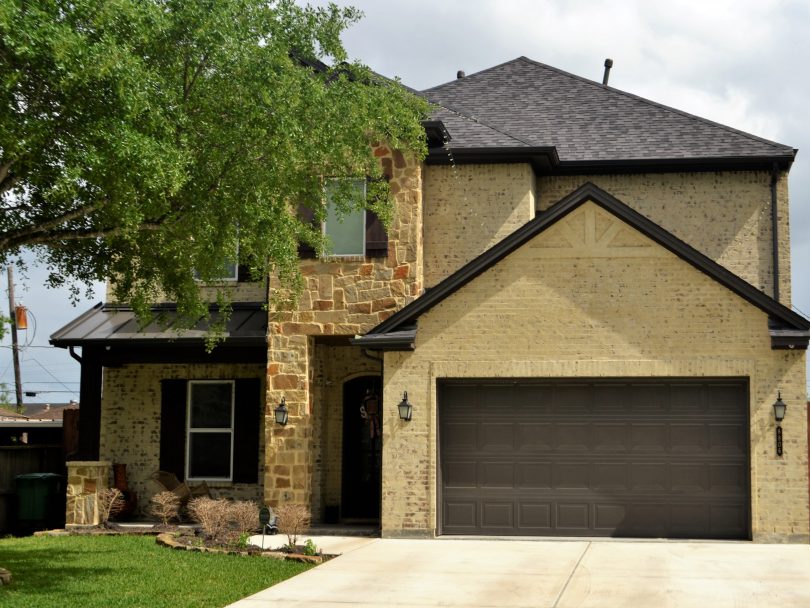By James Dulley
If you have an old, uninsulated garage door, you may want to consider replacing it. This is both for comfort when working on projects in the garage and to reduce energy losses from your house. If your house was built with an inexpensive, inefficient garage door, any bedroom floors above the garage may not be properly insulated either.
When evaluating energy efficient projects, keep in mind that heat energy moves in all directions, including downward. If your garage does not have a heating duct leading to it but it stays reasonably warm, heat is leaking in through adjacent house walls and down from the bedroom floor.
Before you invest in a new, efficient garage door, inspect your existing door. If it is in relatively good condition and there are no significant drafts coming from the joints between the panels, consider installing a garage door insulation kit. Some do-it-yourself kits increase the insulation value by R-8.
A typical kit includes vinyl-backed fiberglass insulation batts, retaining clips and tape. Cut the batts to fit the door panels. Apply strips of double-sided tape on two spots on each panel. Stick the retaining clips on the tape and push the insulation over them. A top clip snaps over each retaining clip to hold the insulation securely in place. Also, put 1/4-inch adhesive-backed foam weather-stripping in the joints.
Several other advantages of installing an insulation kit are reduced outdoor noise in the garage and bedroom above, and reduced lighting costs. The exposed white vinyl backing reflects much light so you should need fewer lights on when working on projects in the garage.
If you decide a new garage door is needed, there are several basic options. The most common garage door materials are wood, insulated steel, insulated fiberglass, and aluminum/glass. Of these, the insulated steel or fiberglass offer the best efficiency with insulation as high as house walls. The overall high efficiency results both from the insulation value and the rigidity of the door, which remains airtight over its life.
Many insulated steel doors are “wind-rated” for severe weather areas. Even if your area does not have frequent severe, high-wind storms, install the horizontal galvanized steel supports across the inner surface of the garage if they were included. While the door is rolling up to open, the door edges are not interlocked to support each other. Without the supports, the panels may flex and develop fatigue cracks over time.
If you prefer the appearance of wood, but want higher efficiency, select a clad insulated steel garage door. A 1/2-inch-thick polymer coating is applied over the exterior steel skin. It has authentic wood grain molded into the surface so it looks identical to real stained wood. A 2-inch thick door with the polymer coating provides R-20.4 insulation. Another attractive option is an embossed simulated wood painted finish providing R-18.4 insulation.
A very popular garage door style today is a simulated swing-open carriage type. It still rolls up like a typical panel garage door, but from the street it appears the two doors would swing open on hinges. These attractive doors often have some type of decorative glass across the top panel for aesthetics and for natural light in the garage.
An insulated steel door is probably the least expensive design to meet your efficiency and comfort needs. The foam inside the door can be either preformed rigid polystyrene or foamed-in-place urethane foam. The urethane foam has a higher insulation level. A lower-cost 1 3/8-inch-thick door with rigid polystyrene still provides R-6.3 insulation.
When choosing a steel door, look for one with a polymer thermal break separating the outdoor and indoor metal skins to reduce heat loss. This is not a factor on a fiberglass door. A 24- to 27-gauge (lower gauge number is thicker) galvanized steel skin is durable. Hot-dipped galvanized steel tracks and 14-gauge hinges are advisable.
If you have children, look for tight-sealing, pinch-resistant panels. The edges are designed to push a finger out of the panel joints as the door closes. Also select a door with an interlocking panel joint design, which creates a tight, long air path to minimize leakage. If you want glass in the garage door for natural lighting, select double-pane, insulated glass.
For more energy efficiency tips, talk to the energy experts at your local electric co-op.
James Dulley writes utility bill-cutting and general money-saving magazine articles and writes nationally syndicated $ensible Home and Cut Your Utility Bills columns for 200 newspapers and magazines.

